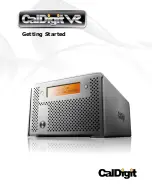
rounded cables such as Antec Cobra Cables. The cables that are included with
your drives should have a red strip on one side indicating pin number 1. If you
use these cables, make sure that the red strip is on pin 1, usually toward the
power connector.
Optional Low Speed Cyclone Blower
We've included an optional low speed Cyclone Blower for users who may want
or need additional cooling for systems built into the Aria. The Cyclone Blower
can be installed in any of the expansion slots.
1. Install the blower in the AGP expansion slot if it is empty.
2. If only an AGP card is used, install the blower in the third expansion slot
(skip one slot).
3. If an AGP card and another card are used (sound card or TV card), install
the blower in the 3rd slot, and install the other card to the 4th expansion
slot (the last slot).
4. If an AGP card, and two other cards are needed, install the blower to the
slot right next to the AGP slot (2nd slot).
Optional Adjustable Fan Bracket
Aria includes an optional fan bracket designed for use with aftermarket CPU
heatsinks. This fan bracket can accommodate fans up to 92mm, but we
suggest you use an 80mm fan.
To use the optional fan bracket:
1. Remove the adjustable sliding rails from the tool box and attach them to
the bottom of the power supply.
2. Attach a cooling fan to the bracket. Be sure that the fan is blowing in the
proper direction; most heatsinks perform best when the fan is blowing air
down onto the heatsink. For best results, please contact your heatsink
manufacturer. Many fans have arrows on the side to show the direction of
the airflow and the rotation of the fan blades.
3. Adjust the position of the fan over the heatsink.
Antec Quality 3-Year parts and labor warranty (AQ3)
See details at: http://www.antec-inc.com/warranty.html
3. Ground Pin: Connect the AUD GND connector to this pin.
4. Front Right Speaker Out Pin: Connect the FPOUT-R connector to this pin.
5. Front Left Speaker Out Pin: Connect the FPOUT-L connector to this pin.
6. Rear Right Speaker Out Pin: Connect the RET-R connector to this pin.
7. Rear Left Speaker Out Pin: Connect RET-L connector to this pin
Note: Your motherboard may not support rear speaker output. In this case, you
do not need to connect RET-R and RET-L.
Installing the Drives
Aria includes a rapid-release flip-up drive cage, which allows easy drive installation.
The cage incorporates four drive bays: one external 5.25" and three internal 3.5".
To install the external 5.25" device:
1. Remove the flip-up drive cage.
2. Insert the 5.25" device and align the screw holes with the rear set of holes
on the cage. Fasten the drive with the included screws (see Photo 1).
3. If you choose not to use the included universal drive bay cover, align the
screw holes with the front set of holes on the cage and fasten the drive
with the included screws.
To install internal 3.5" drives:
You can install up to three internal hard drives. We recommend that you install
your main drive horizontally under the 5.25" bay.
1. Insert the drive into the horizontal 3.5" drive bay and fasten it with the
special screws (those with the rubber grommets).
Note:
The special screws
will reduce noise by absorbing vibrations from your hard drive, but they can
only be used with the horizontal bay. (For the two vertical bays, you'll need
to use normal screws.) In addition, there are two strips of thermal tape
located on each side of the horizontal bay, which will help transfer heat
from the HDD to the cage (see Photo 2).
2. You can also install two hard drives vertically on either side of the 5.25"
bay. A strip of thermal tape is also preinstalled in each of these drive bays.
Fasten the drives as described above.
Note:
You may not be able to use the
additional vertically-mounted 3.5" drive bays, as they may interfere with
the internal components. Do not use the grommetted screws on the vertical
3.5" drive bays, because they will interfere with the top cover of the case.
Connecting Data Cables
After you've connected the devices to the power supply, you need to connect
the data cables between the devices and the motherboard. To achieve the best
data-transfer and cooling performance, Antec recommends using premium
Photo 1
Photo 2
6
5
ARIA_Int_Manual.qxd 2/27/2004 2:50 PM Page 10






















